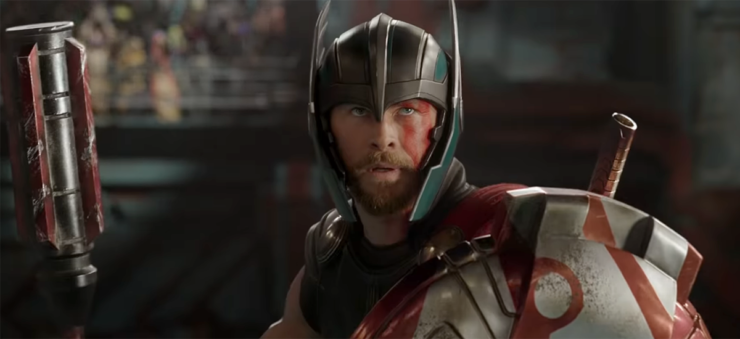After buggering off at the end of 2015’s Avengers: Age of Ultron, Thor had been conspicuously absent from the next appearance of the Avengers as a team, 2016’s Captain America: Civil War (which we’ll cover next week). This was, in fact, a minor plot point, as Secretary Ross pointed out the absence of both Thor and the Hulk.
Thor finally showed up in the other 2016 release, Doctor Strange, and that was to set up his third movie, released in 2017.
Despite the mediocre word of mouth surrounding Thor: The Dark World, not to mention people ranging from the director, Alan Taylor (who did not enjoy how the film was edited), to two of the actors, Christopher Eccleston (who disliked the heavy makeup) and Natalie Portman (who was upset that Patty Jenkins was dismissed from directing the film), bad-mouthing the film, a third film was nonetheless listed as part of Phase 3 of the Marvel Cinematic Universe when it was announced in 2014. It had a very provocative subtitle to anyone who has followed Norse myth (or read Thor comics): Ragnarok, the end of all that is from Norse mythology.
Taika Waititi, an independent film director with a very distinctive style, was brought in, having apparently learned their lesson from the first film, where Kenneth Branagh provided an appropriately Shakespearean gravitas to the proceedings. Waititi brought his own brand of lunacy to the film.
Several comics were mined for the storyline, most notably two aspects of Walt Simonson’s definitive run on Thor in the 1980s—his own Ragnarok story that covered his first year or so on the title, as well as the subsequent story that had Thor leading an expedition to Hela’s realm to rescue innocent human souls—and the “Planet Hulk” storyline written by Greg Pak in Incredible Hulk in the mid-2000s.
Back from Doctor Strange are Chris Hemsworth as Thor and Benedict Cumberbatch as Doctor Strange. Back from Age of Ultron are Mark Ruffalo as Bruce Banner and the Hulk, and Idris Elba as Heimdall (in addition, archive footage of Scarlett Johansson as Natasha Romanoff from AoU is used). Back from The Dark World are Tom Hiddleston as Loki, Sir Anthony Hopkins as Odin, Tadanobu Asano as Hogun, Ray Stevenson as Volstagg, and Zachary Levi as Fandral. Introduced in this film are Cate Blanchett as Hela (inexplicably changed to Thor and Loki’s sister), Tessa Thompson as the Valkyrie (very loosely based on a comics character from The Defenders), Karl Urban as Skurge (based on the longtime villain the Executioner), Jeff Goldblum as the Grandmaster (another Elder of the Universe from the comics like the Collector), Waititi as Korg, Clancy Brown as the voice of Surtur, and Sam Neill, Luke Hemsworth (Chris’s brother), and Matt Damon as actors portraying, respectively, Odin, Thor, and Loki in a play. Jaimie Alexander was originally intended to return as Sif, but the shooting schedule for her TV series Blindspot did not allow for her to do so (which means she’s still available to come back at some point).
Hemsworth, Cumberbatch, Ruffalo, Elba, and Hiddleston will next be seen in Avengers: Infinity War. Thompson and Waititi will next be seen in Avengers: Endgame.
“I hate this prophecy”
Thor: Ragnarok
Written by Eric Pearson and Craig Kyle & Christopher L. Yost
Directed by Taika Waititi
Produced by Kevin Feige
Original release date: November 3, 2017
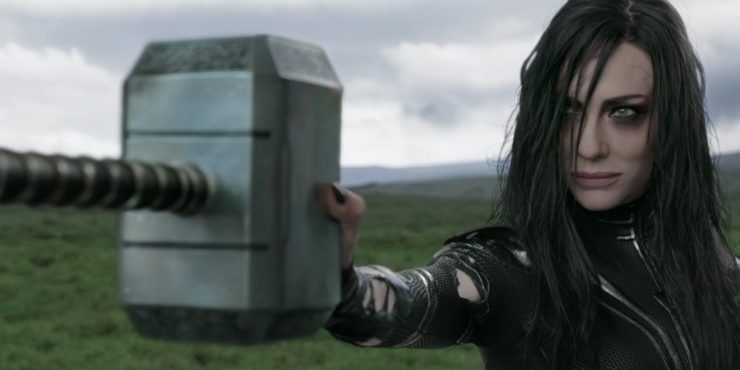
Thor is trapped in a cage, providing exposition to the audience under the guise of having a one-sided conversation with the skeleton in the cage. We find out that he has spent the last two years looking for the other four infinity stones, but not found any. He is eventually freed by his jailer, Surtur, who plans to bring about Ragnarok, the end of the world on Asgard. Thor says that Odin will stop him, but Surtur says that Odin is no longer in Asgard.
Surtur very generously exposits that all Surtur has to do is place his crown into the eternal flame, and he will be able to destroy Asgard. At that point, Thor breaks out of his chains, summons Mjolnir to his hand, and fights Surtur, ripping the crown from his head. Surtur’s minions attack him, and so Thor asks Heimdall to bring him back to Asgard.
Unfortunately, Heimdall no longer guards the Bifrost. A lowly Asgardian named Skurge is now in charge, Heimdall having been charged with treason—but not captured, as it’s hard to capture someone who can see and hear everything. Skurge eventually stops flirting with two women to do his job and get Thor home, and then Thor flies to the palace.
As we saw at the end of The Dark World, Loki is posing as Odin. He has commissioned a play about Loki’s death in that movie, which is overwritten and overacted like whoa. Thor calls out Loki, throwing his hammer far and putting “Odin” between himself and Mjolnir’s flight path back, at which point Loki shows his true face for the first time in a while.
Loki didn’t kill Odin, he just sent him to an old folks’ home on Earth. But when they arrive in New York, they find that the place has been demolished. Doctor Strange sends Loki into a portal and summons Thor to his sanctum. Strange has been in touch with Odin, but couldn’t tell Thor where he was because Thor hadn’t been on Earth since Odin’s arrival. However, Strange is willing to send the pair of them to Norway, where Odin is, provided they then return to Asgard. Thor agrees, and only then does he free Loki, who has been falling for half an hour before Strange let him out. Loki wishes to get revenge for this indignity, but Strange sends them to Norway before he can.
Odin is standing alone in a field. His time has come, and he’s about to die—which means that their sister will be unleashed. Apparently, Odin had another child before Thor and Loki, whom he was forced to exile and imprison, but when Odin dies, Hela, the goddess of death, will be free. After a final moment between father and sons, he discorporates.
A moment later, Hela shows up. She’s immensely powerful, as proven when Thor throws Mjolnir at her and she catches it and destroys it with one hand. Loki calls for Skurge to take them to Asgard, but she follows them across the Bifrost and attacks them both, sending them careening out of the Bifrost and into space.
Hela arrives at the Bifrost, which is now being run by Volstagg and Fandral, with Skurge reduced to sweeping the floor. Hela kills the warriors instantly, and recruits Skurge. She declares herself the rightful queen of Asgard—removing the paintings in the palace that show only Odin, Thor, Sif, and the Warriors Three fighting in battle and showing what’s under them: Odin and Hela conquering dozens of worlds.
She faces off against the Einherjar, led by Hogun, and kills them all when they refuse to bend their knee to her. Her plan is to use the Bifrost to conquer as many worlds as she can—but the sword that powers it has gone missing. Heimdall has snuck into the Bifrost and stolen it, using it to defend himself as he gathers refugees in a place where Hela cannot find them.
For his part, Thor finds himself landing on the world of Sakaar, a world proximate to many jump portals. He is initially captured by scavengers who view him as food—Thor takes out several of them before they hit him with an electronic net—and then he’s taken from them by a slave trader whose designation is Scrapper 142, who has a powerful ship that enables her to take out the scavengers, despite her being exceedingly drunk.
She brings him to the Grandmaster, an ancient being who runs the Contest of Champions on Sakaar, one of the biggest gladiatorial attractions in the galaxy. Thor puts up a good fight, but he is unable to break out of his restraints. The Grandmaster pays her handsomely for “the Lord of Thunder.” Thor sees Loki, who apparently arrived weeks before—time moves strangely on Sakaar—and has inveigled himself into the Grandmaster’s good graces. But Loki denies knowing Thor to the Grandmaster.
Later, Loki sends a holographic construct to visit Thor in prison. Thor is livid at Loki, as his exiling Odin led to his death, which led to Hela returning and taking over Asgard. Thor makes friends with two other prisoners, Korg and Miek. Korg is a gentle, but strong rock creature who usually does the undercard fights. Thor, though is being pitted against the Grandmaster’s champion, against whom no one has been victorious.
Thor is given a makeover, his hair cut by a high-tech barber who looks just like Stan Lee, and is given a new set of armor.
He’s put in the arena, where his foe turns out to be the Hulk. Thor is thrilled to see him (“He’s a friend from work!”); Loki, not so much (“I have to get off this planet,” he mutters furtively while looking more frightened than Loki has ever looked). Thor doesn’t wish to fight his teammate, but the Hulk very much wants to.
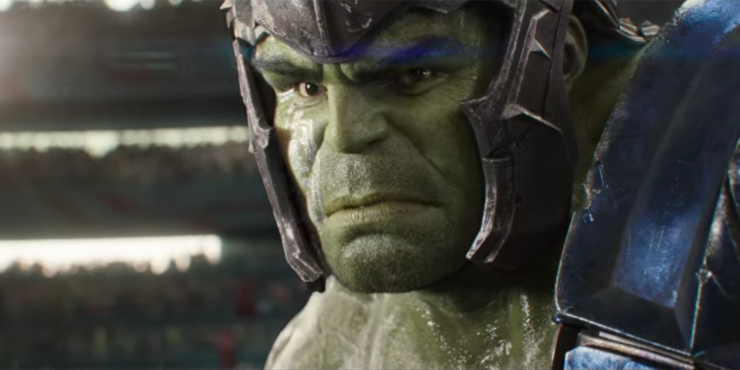
Thor puts up a better fight than anyone has against the Hulk. At one point, he tries the “sun’s going down” trick that Natasha Romanoff used in Age of Ultron to calm the Hulk down so he can change back to Bruce Banner, but it doesn’t work. (At one point, Hulk slams Thor repeatedly back and forth on the ground, and Loki cries out, “Yes! That’s what it feels like!”)
And then Thor finds himself able to channel lightning through his fingertips and zaps the Hulk badly.
Before his champion can be defeated, Grandmaster activates the control on Thor’s neck that 142 put there, rendering him unconscious.
This allows Hulk to win, still, but Thor survives the encounter, and is given better quarters, shared with the Hulk. The two Avengers catch up, though Hulk insists that Thor only likes Banner, not Hulk. Thor unconvincingly denies this.
Hulk reveals that he came to Sakaar on a quinjet, which he points to the wreckage of. Thor views that quinjet as their ticket back to Asgard.
It turns out that 142 is an Asgardian, specifically one of the Valkyrior. Most of the Valkyries were massacred by Hela before Odin imprisoned her. The Valkyrie has no interest in returning to Asgard and the politics there, preferring to live on Sakaar and drink herself into insensitivity. The news of Odin’s death only gives her temporary pause—but it’s enough for Thor to snatch the control for his implant. He is able to escape the quarters via the window and tries to activate the quinjet. However, Hulk follows him to the quinjet, trashing it just by entering it, though Thor is able to use footage of Romanoff speaking to him to calm him enough to transform back to Banner.
Banner’s first question is if they saved Sokovia or not. He’s been the Hulk for two years straight. Banner is half-convinced that if he becomes the Hulk again, he’ll never be able to change back to Banner. Thor tries to console him, but Banner—who is very freaked out at being on another planet—refuses to accept it, thinking that Thor likes the Hulk, not Banner. Thor’s denial of this is equally unconvincing, given that his plan is to take a team back to Asgard to fight Hela.
Thor contacts Heimdall, who informs him of the situation on Asgard. Heimdall says the largest portal near Sakaar will take them to Asgard.
Grandmaster is livid at losing both his champion and that champion’s strongest challenger. He charges the Valkyrie and Loki to find them. However, Valkyrie turns on Loki and captures him, then finds Thor and Banner (not realizing that Banner is the erstwhile champion) and agrees to go back to Asgard and stick it to Hela. Valkyrie knows a route that will take several months, but Thor points at the largest portal and says they will go through that—which is apparently named the Devil’s Anus, likely by a twelve-year-old. But Valkyrie’s ship can’t handle that portal—however, Loki offers access codes to the Grandmaster’s ships in exchange for his freedom.
Valkyrie gives Korg and Miek weapons and their freedom from the implants. With the prisoners distracting the Grandmaster’s forces, Thor and Loki sneak into the port and steal a ship. Well, Thor does—Loki proves himself duplicitous as ever, and plans to turn Thor in to the Grandmaster for a reward. However, Thor—who did grow up with Loki—sees the treachery coming and snuck an implant onto Loki’s back and turns it on, tossing away the controller, leaving Loki to twitch on the deck.
Thor steals the Grandmaster’s yacht, picking up Valkyrie and Banner, though the former attacks the pursuit ships chasing them with her mighty sword Dragonfang. Thor decides to help her out, even though she doesn’t need it, because it’s his movie, leaving Banner to awkwardly figure out how to fly the ship.
The three of them go through the portal to confront Hela. However, she and Skurge are moving in on Heimdall’s position, as an Asgardian gave away Heimdall’s location rather than see an innocent executed by Skurge. (For his part, Skurge doesn’t look thrilled with being ordered to behead an innocent person.) However, Heimdall, naturally, saw them coming and gets the refugees to the rainbow bridge.
The confrontation happens there. Hulk takes on Fenris Wolf, the massive canine enforcer of Hela’s. (Banner can’t just stand by and let innocent people be killed, so he risks changing back into the big guy.) Thor, Valkyrie, and Heimdall, as well as many of the refugees, take on Hela’s forces, which consist of her former soldiers brought back to life.
Korg and Miek show up with Loki, the former having rescued the latter during their revolution. They arrive in a gigunda ship, to which Heimdall takes the refugees. Belatedly realizing he’s fighting on the wrong side, Skurge turns on Hela, sacrificing his life so that they can escape.
Thor is being beaten very badly by Hela, who cuts out his right eye, so he now resembles his father. Hela reminds Thor that she’s the goddess of death. “What are you the god of, again?”
Suddenly, seemingly on the astral plane, Thor and Odin have a conversation where father reminds son that he’s the god of thunder, not the god of hammers. Mjolnir was just to help him control it. Why he needed to be told this now when he already knew he could do this from the fight in the arena with the Hulk is left as an exercise for the viewer.
Hela’s power comes directly from Asgard itself, so Thor hits on the notion of destroying her power source. He has Loki put Surtur’s helm in the eternal flame, which summons Surtur to Asgard, so he can destroy it. (On the way, Loki sees the Tesseract and swipes it. This will be important in Avengers: Infinity War.)
The refugee ship leaves Asgard. Once Surtur and Hela go at it, Hulk—who has finally defeated Fenris—grabs Thor and Valkyrie and leaps with them up to the ship.
They sail off into the night. Thor decides to set course for Earth. Loki is concerned that Earth may not welcome him, but it becomes moot when the ship is confronted by a much larger ship belonging to Thanos…
Meanwhile, on Sakaar, Grandmaster tries to make the best of the revolution that has overthrown him as he can.
“I make grave mistakes all the time”
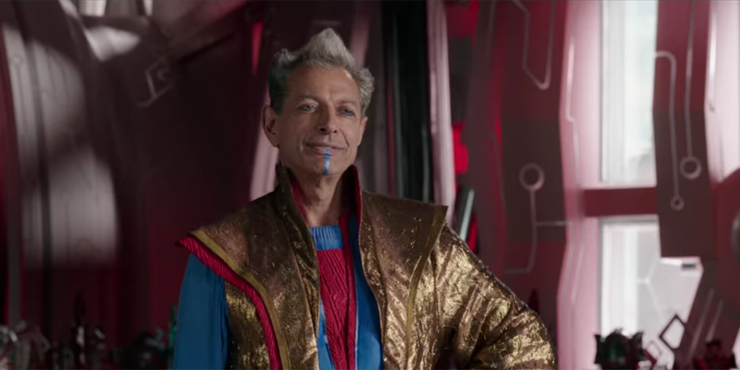
I both love and hate this movie in equal measure.
As an action-adventure movie, it’s excellent. As a part of the MCU, it’s good. As a Hulk movie, it’s fantastic.
As a Thor movie, it makes me want to scream and shout and rip the DVD from the player and jump up and down on it several dozen times.
I hate this as a Thor movie, deeply and truly.
One of the great things about Marvel’s version of the character of Thor is that it is able to make use of the magnificent tapestry of Norse mythology. One of the annoying things about the MCU version of Thor is its lack of willingness to seriously tap into that. And then in this movie, they trash it all together.
A common thread in many of the twentieth-century superhero movie adaptations is an inability to take the source material seriously, indeed to treat the material with contempt. This sometimes still results in good work—e.g., Kenneth Johnson’s adaptation of the Hulk for television in the late 1970s. But that contempt can work against you.
Back in the rewatch of Thor I briefly brought up the issue that, if Thor and Loki were still kids a thousand years ago, how did the stories about them (which Eric Selvig went and dug out of the local library!) come to pass? If Snorri Sturluson knew that Loki was half-frost giant, why didn’t Loki himself know it?
This movie has the same issue. Hel is a major figure in Norse myth, the northern European equivalent of Pluto or Hades or Lucifer: the person in charge of the land of the dead. She’s also Loki’s daughter in Norse myth. (Stan Lee and Jack Kirby changed her name to Hela probably because the Comics Code Authority would balk at her original name.) To change her to Thor and Loki’s long-lost sister that they’d never heard of—again, why don’t they know who she is when people on Earth who’ve studied Norse myth do?—is a random and stupid change that adds nothing to the story of significance. Seriously, the fact that she’s Thor’s sister has no real effect on the plot that actually matters in the movie, beyond Banner initially not wanting to get involved because Thor makes it sound like a sibling rivalry rather than a coup on Asgard.
Worst of all, though, is that this movie redshirts the Warriors Three, and would have done the same for Sif if Jaimie Alexander wasn’t too busy starring on a TV show (which is the first nice thing I’m willing to say about Blindspot, which is a really dreadful series). It’s obvious that Hogun’s final confrontation with Hela was originally meant for Sif, and it would have been a truly despicable and horrific end to one of Marvel’s strongest female characters. But even without Sif, this is a contemptible misuse of three of Marvel’s most venerable and delightful supporting characters, who were established in Thor as being his nearest and dearest comrades. And this movie just kills them perfunctorily without even much of a fight, just so they can show how badass Hela is. Except we know how badass Hela is already—she fucking blew up Mjolnir with one hand! Her badassitude was well established, so there was no need to just cast aside Thor’s three best friends on the altar of proving it once again. Especially since Thor never once even asks about Hogun, Fandral, or Volstagg. Their deaths are never passed on to him, he never gets a chance to mourn them, or even give any indication that he gives a rat’s ass about them. The only non-family Asgardian he has any significant interactions with is Heimdall, who gets treated generally way better, I guess because he’s played by a more famous actor.
And then in the end they blow it all up. Sure, Asgard was destroyed in the comics at one point, but that was after decades of stories, not a tiny handful of them.
Then there’s Skurge, which is a different kind of mistake.
I’ve said this before: The best superhero comics adaptations are ones that distill decades of history into a single movie (Iron Man is a particularly good example of this). The worst are the ones that compress decades of history into a single movie (Spider-Man 3 is a particularly sad example of this). It’s all well and good to use the comics as source material, even using individual sets of pages as your storyboard. We just saw that last week, with Scott Derrickson using the opening bit in Doctor Strange: The Oath with Strange’s astral form kibitzing over his physical form being operated on.
The death of Skurge in Thor #382 is one of the many many many great, brilliant, magnificent moments in Walt Simonson’s deservedly famous run on the title. Skurge, nicknamed the Executioner, had been the textbook definition of a minor villain since he was introduced in Journey into Mystery in 1964 as a lackey of the Enchantress. After their attack on Thor in that issue, they’re exiled to Earth and join up with Baron Zemo’s Masters of Evil, one of the Avengers’ long-running foes.
Over the decades, the Executioner rarely elevated himself above the ranks of big dumb sidekick to the Enchantress. He wasn’t even always used with her, and never amounted to much of anything. The Enchantress herself often treated him dismissively.
So when he joins the expedition to retrieve lost souls from Hela’s domain in the storyline that climaxes in Thor #382, it seems a bit odd, but then he defends the bridge at Gjallerbru, the last stand against the hordes of Hela that allows Thor, Balder, and the rest to escape with the stolen souls. It’s a magnificent moment, one of the best in Thor’s comics history, and it works because it’s the final redemption of a second-rate character who finally found his place in the great stories of the warriors of Asgard.
By comparison, for all that Karl Urban does his usual spectacular job of making Skurge into a three-dimensional character, there just isn’t time, with everything else going on, for Skurge’s journey from toady to hero to land properly. It’s less an adaptation of the sequence in the comics and more a pale imitation of it.
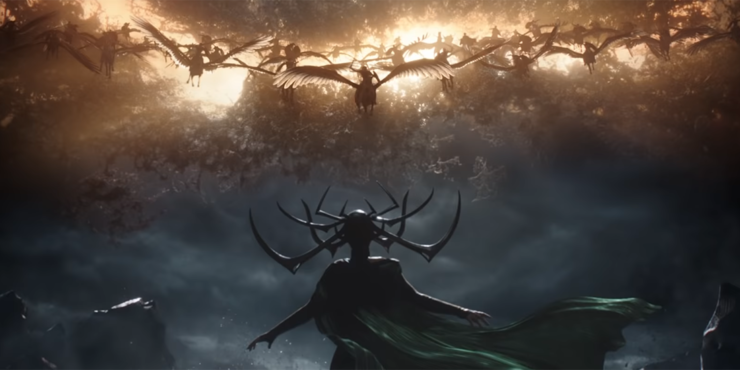
This is all made infinitely more frustrating by the fact that this wholesale mistreatment of Asgard and the Norse gods and the history in both comics and mythology of these characters is all framing a movie that’s actually tremendous fun.
The opening bits are superb, from Thor’s action-filled and hilarious battle with Surtur (though, again, why doesn’t Thor know all this stuff about Ragnarok when it’s been known to humans on Midgard since forever?).
His exposure of Loki’s disguise is hilarious. Sir Anthony Hopkins nails it, perfectly doing Loki imitating Odin. The play—performed by Sam Neill, Matt Damon, and Chris Hemsworth’s brother—is a thing of beauty, complete with a delightful callback to one of the most magnificently surreal moments in Thor comics, when Loki turned Thor into a frog. (Yes, really. Do yourself a favor, do what you can to track down copies of Thor #364-366 from 1986. You won’t regret it. “In this issue, Thor croaks!”) The search for Odin gives us a hilarious cameo from Doctor Strange, followed by a truly tragic final scene between a father and his contentious sons.
The scenes on Sakaar are where the movie shine, of course. Taika Waititi gives the whole thing an Eighties action-movie vibe, from the bright colors to the over-the-top Kirbyesque outfits to the very Max Headroom-ish holographic images of the Grandmaster to the soundtrack to hitting every cliché of the people-trapped-in-a-gladiatorial-arena storyline. Waititi throughout the movie dances on the edge between drama with comedic overtones and out-and-out slapstick, and it’s to his credit that he generally maintains his balance. (He only goes over the edge a few times, like the “devil’s anus” joke, which I’m sure some people found funny, but struck me as a little too pre-pubescent-giggly.)
And, as I said above, this is a great Hulk movie. I maintain that Avengers is the best Hulk movie yet made, and this doesn’t quite blow past it; however, it sits comfortably in the second spot, in my opinion. Mark Ruffalo remains magnificent, playing the Hulk’s childlike mien both in the arena and when talking to Thor in their shared quarters, as well as Banner’s befuddlement and attempt to figure out what the heck’s going on when he wakes up for the first time in two years. The character’s heroism shines through, as well, as he very much wants to do the right thing, even if it means sacrificing his own humanity.
Ruffalo is but one of a dozen actors doing great work here, as no matter what the issues with the story, there’s not a bad performance in the bunch. Chris Hemsworth and Tom Hiddleston remain a superb double act, from their confrontation on Asgard to their seeking out Odin on Earth (and kudos to the costuming department, as the civilian clothes they each wear to blend in on Earth are perfect) to “get help.” I love that Thor actually anticipates Loki’s sudden-but-inevitable betrayal and deals with it, and the two have a sibling chemistry that is spot on. I particularly love both their reactions to the Hulk’s arrival. Thor is delighted, of course, as seeing the Hulk is the first good thing that’s happened to him since he went home to Asgard, but what I especially love is the look of sheer terror on Hiddleston’s face as Loki sees the creature who slammed him into the floor over and over again in Stark Tower.
The rest of the cast shines as well. Hopkins, as I said, nails his role, from playing Loki impersonating Odin to playing a dying Odin who carries the weight of his decisions (mostly the bad ones) all the way to his grave. Idris Elba is never not awesome as Heimdall (or as anyone, truly), Tessa Thompson does a sterling job as the drunken PTSD Valkyrie, and Cate Blanchett is superlative playing Hela as, basically, the queen of the Goths. (Amusingly, Blanchett plays Hela pretty much the same way she played Lou in Ocean’s Eight, which is just fabulous.) Waititi himself is tremendous fun as Korg, who sounds like a cross between a Hawai’ian surfer and (according to Waititi himself) a Polynesian bouncer.
And holy crap, Jeff Goldlbum. I love the way he does the Grandmaster as a mixture of Max Headroom, Richard Dawson’s Damon Killian in The Running Man, and, well, Jeff Goldblum as his Jeff Goldblummiest. Just a sheer joy from the moment he shows up on screen. Points also to Rachel House, who has the thankless job of playing the Grandmaster’s sidekick with an animus for one of the heroes who gets a shot to kill them and is instead defeated. (Like I said, every cliché….)
Amidst all the goofy jokes and slapstick bits, there’s some good discoursing on heroism here, as Thor never once loses sight of the fact that he’s in this to save people. Neither does Banner, and part of the fun of the film is watching the Valkyrie get back into that particular headspace.
Still don’t see why they had to trash Asgard, too. (And then they double down on it in Infinity War, but we’ll get to that down the line…)
Next week, we come back to Earth to look in on the rest of the Avengers in Captain America: Civil War.
Keith R.A. DeCandido has written prose featuring both Marvel’s version of Thor—in the Tales of Asgard trilogy, starring Thor, Sif, and the Warriors Three—and the original Norse god Thor—in the tales of Cassie Zukav, weirdness magnet.










